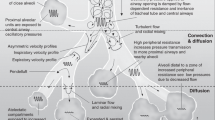Abstract
High-frequency ventilation, which we have termed “high-frequency positive-pressure ventilation” (HFPPV), can serve as an alternative to treatment by standard intermittent positive-pressure ventilation in certain types of acute respiratory distress in the newborn. Its use in the pre-, intra- and/or postoperative period in neonatal surgery is of interest if certain reservations are borne in mind: regarding technological requirements, a ventilator with low internal static compliance must be available; it must be possible to monitor various ventilatory parameters accurately: PaO2, PaCO2, airway pressure variations. We shall describe our experience at the Department of Pediatric Surgery of the C. H. U. in NANCY with three cases of esophageal atresia and ten cases of diaphragmatic hernia in children who benefited from this treatment. The indications for HFPPV are defined with regard to the advantages and disadvantages presented by this technique. When treating diaphragmatic hernias, there are benefits with regard to respiratory constants and control of airway pressure: reducing the peak pressure with improvement of PaO2 and lowering of PaCO2, which lowers the incidence of regression to fetal circulation (eight of ten infants survived). Then are also advantages in esophageal atresia: reduction of flow at the fistula, if present, and stabilization of the surgical field, thus facilitating surgery. The literature available on the types of procedures in which HFPPV can be beneficial is limited. Most of the studies have focused on the absence movement in the surgical field: open thoracic surgery, tracheal surgery, surgery for patent ductus arteriosus and microneurosurgery are all procedures in which this type of ventilation can be valuable.
Similar content being viewed by others
References
Baum M, Benzer H, Geyer A, Mutz N (1983) Transport intra-pulmonaire des gaz en ventilation à haute fréquence. In: Ventilation à haute fréquence, Anesthésie-Réanimation, Pitié-Salpétrière, libr. Arnette.
Bland R, Sedin E (1980) High frequency mechanical ventilation in the treatment of neonatal respiratory distress. Crit Care Med 8: 275–280
Bland R, Kim MH, Light MJ (1977) High frequency ventilation of low-birth infants with respiratory failure from hyaline membrane disease: 92% survival. Pediatr Res 11: 531–538
Boros SJ, Campell K (1980) A comparison of the effects of high frequency-low tidal volume and low frequency-high tidal volume mechanical ventilation. J Pediatr 97: 108–112
Bunegin L, Smith B, Sjöstrand UH (1984) Regional organ blood flow during HFPPV and IPPV Anesthesiology 61: 416–419
Drummond WH, Gregory GA, Heymann MA (1981) Independent effects of hyperventilation, tolazoline and dopamine in infants with persistent pulmonary hypertension. J Pediatr 98: 603–611
Durand JP, Guyard MF, Ensel J (1983) Hernie postéro-latérale de la coupole diaphragmatique gauche du nouveauné. Guérison d'une hypoxémie réfractaire par nifédipine. Presse Méd 12: 2114
Eriksson I (1983) Bases théoriques de la ventilation en pression positive à haute fréquence. In: Ventilation à haute fréquence, Anesthésie-Réanimation, Pitié-Salpétriére, Libr. Arnette.
Eriksson I, Sjöstrand UH (1980) Effects of HFPPV and general anesthesia on intrapulmonary gas distribution in patients undergoing diagnostic bronchoscopy. Anesth Analg 59: 585–593
Eyal FG, Arad ID, Godder K (1984) High frequency positive pressure ventilation in neo-nates. Crit Care Med 12: 793–797
Gibbons PA, Schlichting CM, Downes JJ (1983) Hernies diaphragmatiques congénitales du nouveau-né. Rev Pediatr XIX, (8): 433–441
Inserm — CNRS (1984) Régulations calciques dans les muscles lisses. Aspects biochimiques et physiologiques. Editions Inserm, Bordeaux
Karl SR, Ballatine TWN, Snider MT (1983) High frequency ventilation at rates of 375 to 1800 c.min-1 in four neonates with congenital diaphragmatic hernia. J Pediatr Surg 18: 822–828
Kirby RR (1984) Limits and cautions with the use of high frequency ventilation. Crit Care Med 12: 827–828
Malina JR, Nordstrom SG, Sjöstrand UH (1981) Clinical evaluation of HFPPV in patients schedulded for open chest surgery. Anesth Analg 60: 324–330
Murat I, Laguenie G, Couturier C (1983) Ventilation à haute fréquence durant la cure chirurgicale de l'atrésie de l'oesophage. Ann Fr Anesth Réanim 2: 270–272
Mutz N, Baum M, Benzer H (1984) Intra-operative application of high frequency ventilation. Crit Care Med 12: 800–802
Primhak RA (1983) Factors associated with pulmonary air leak in premature infants receiving mechanical ventilation. J Pediatr 102: 764–768
Schmitt M, Pierre E, Prevot J, Lotte E, Droulle P (1985) Les hernies diaphragmatiques congénitales. Diagnostic anté-natal. Drainage thoracique. Ventilation à haute fréquence. Chir Pediatr 26: 8–12
Seki S, Goto K, Kondo T (1984) Gas exchange and facilitation of high frequency ventilation in intrathoracic surgery. Ann Thorac Surg 37: 491–496
Sjöstrand UH (1977) Review of the physiological rationale for and development of HFPPV. Acta Anesth Scand 64 (suppl): 7
Sjöstrand UH (1980) High frequency positive pressure ventilation (HFPPV): a review. Crit Care Med 8: 345–364
Sjöstrand UH (1983) Développement et application clinique de la ventilation à haute fréquence avec des systèmes à compression basse. In: Ventilation à haute fréquence. Anesthésie-Réanimation. Pitié-Salpétrière, Libr. Arnette.
Slutsky AS (1984) Mechanisms affecting gas transport during high frequency oscillation. Crit Care Med 12: 713–717
Stocks J Godfrey S (1976) The role of artificial ventilation, oxygen and CPAP in the pathogenesis of lung damage in neonates: Assessment by serial measurements of lung function. Pediatrics 57: 352–361
Sutton JE, Glass DD (1984) Airway pressure gradient during high frequency ventilation. Crit Care Med 12: 774–776
Special conference report (1983) High requency ventilation for immature infants. Report of a conference, march E-4-1982. Pediatrics 71: 280–287
Author information
Authors and Affiliations
Additional information
Offprint requests to: J. Prevot at the above address
Rights and permissions
About this article
Cite this article
Schmitt, M., Prevot, J., Lotte, E. et al. Relevance of high-frequency ventilation in neonatal surgery. Pediatr Surg Int 1, 55–59 (1986). https://doi.org/10.1007/BF00171784
Issue Date:
DOI: https://doi.org/10.1007/BF00171784




